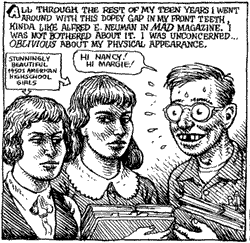
|
"Mystic Funnies" starts out with the story of "The Hipman," another of Crumb's acid portrayals of a modern, frustrated, vulgar American. Sporting a mullet and a T-shirt that says "Empire Builder" on it, Hipman drives around in his one-man European car, worrying about how hip he is. Since this is a Crumb comic, a big-legged, big-chested Amazon soon puts him out of sorts, getting him in trouble with an even more diminutive, backwards-baseball-capped, trash-talking "gangsta'" named "Fishlips." Every era has received a similar razzing at the hands of Mr. Crumb. Fritz the Cat, happy-go-lucky and free lovin' until getting offed by his crazy ostrich girlfriend, became iconic of the sixties and seventies. The new volume of "Complete Crumb," which covers his work from the mid-1980s, includes strips with Mode O'Day, an archetype of that era's material-obsessed superficiality. But "The Hipman," sad to say, seems a bit out of touch. Mullets? That was so early nineties. It reads like the work of an expatriot.
 The teen-age Crumb says hello to a pair of "stunningly beautiful 1950s American highschool girls" in "Mystic Funnies" #3
The teen-age Crumb says hello to a pair of "stunningly beautiful 1950s American highschool girls" in "Mystic Funnies" #3 |
The supporting stories have a much sharper bite, including a return to his painfully confessional autobiographical style. A classic example appears in the latest "Complete Crumb." "Footsy," rendered in a dramatic chiaroscuro, tells of his teenage encounters with the feet of various "lusty creatures" at school. For the new story, "Don't Tempt Fate," Crumb has abandoned the rich blacks that characterized this part of his career in favor of a crosshatching technique that captures every ripple of flesh and clothing. "Fate" tells the story of how a playmate accidentally smashed Crumb's mouth, leaving him with an absurd, gap-toothed grin all through adolescence. Not so funny? Wait till you see. Crumb's willingness to show himself in the most unflattering way turns the pain into humor.
"Mystic Funnies" #3 ends with the kind of story that made Crumb famous — the like of which he hasn't touched in years — dirty, funny animals. This "Fritz the Cat" style combines Crumb's two biggest comic influences: the anarchic early issues of "Mad" magazine and the simplicity of the Donald Duck comics. This one stars "Super Duck, The Cockeyed Wonder." Uwanna, "Super Duck's" girlfriend, gets tired of him falling asleep on the couch after making him dinner. So Supes orders some special pills from the back of the "Beat Off" magazine his nephew Fauntleroy gets caught reading. But the pills turn out to be a bit more than Supes can handle. "Blurp!" "Plup!" "Splap!" and "Shlup!" are about the only remaining parts of this gut-busting farce I can include here.
By sampling each of Robert Crumb's most famous styles, "Mystic Funnies" #3 works as a less expensive version of the "Complete Crumb" series. Both newcomers and long-time fans should be pleased.
"Mystic Funnies" #3 can be found at smart comic stores. "The Complete Crumb Comics," volume 16 can be found at both comic shops and regular bookstores.
